|
|
|
Sort Order |
|
|
|
Items / Page
|
|
|
|
|
|
|
| Srl | Item |
| 1 |
ID:
137493
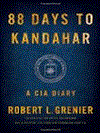

|
|
|
|
|
| Publication |
New York, Simon and Schuster, 2015.
|
| Description |
xix, 443p.Hbk.
|
| Standard Number |
9781476712079
|
|
|
|
|
|
|
|
|
|
|
|
Copies: C:1/I:0,R:0,Q:0
Circulation
| Accession# | Call# | Current Location | Status | Policy | Location |
| 058169 | 958.104/GRE 058169 | Main | On Shelf | General | |
|
|
|
|
| 2 |
ID:
137235
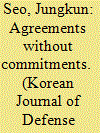

|
|
|
|
|
| Summary/Abstract |
Twenty years after the deal struck between the United States and North Korea over the nuclear crisis, the security environment on the Korean Peninsula remains unstable. When it comes to the U.S.-North Korea Agreed Framework from 1994 through 2002, previous research has paid scant attention to how the U.S. Congress responded to President Clinton’s accord with the Pyongyang regime. This article
provides a rare empirical assessment of what led America’s lawmakers to uphold or overturn the executive agreements with North Korea. The bottom-line finding is that politics hardly stops at the water’s edge, with “politics-as-usual” forces such as partisan conflicts ultimately having derailed Congressional commitments to the U.S.-DPRK accords. The results shed light on how and why domestic politics often redirects the course of international agreements, particularly in the era of
polarized politics.
|
|
|
|
|
|
|
|
|
|
|
|
|
|
|
|
| 3 |
ID:
137226
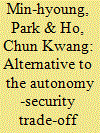

|
|
|
|
|
| Summary/Abstract |
Most of the alliances that were formed during the Cold War period were known as a so-called “asymmetric alliance,” which means strong states provide one-sided support for the partner in a relationship at the expense of the weaker power’s autonomy. In an asymmetric alliance, a weak state gets full security support from the superpower, but in return, the weak state loses its autonomy. In this case, there is a trade-off between security and autonomy of the weaker state. This is what the Autonomy-Security Trade-off Model suggests. However, after the end of the Cold War, the weak powers, especially the developing country, have tried to increase its autonomy without any loss of its security—unlike what the Autonomy-Security Trade-Off Model argues. In this case, there may not be necessarily a trade-off between autonomy and security if a weak state decides to increase both autonomy and security simultaneously. The weak state does not usually want to lose its security, therefore it tries to find a strategy that can increase its autonomy without decreasing its security. In this sense, this paper argues that the Autonomy-Security Trade-off model has limitations to explain the above kind of national action after the Cold War. In line with this, the goal of this paper is to offer an alternative model to explain an asymmetric alliance relationship by looking at the case of the
ROK-U.S. alliance at the turn of the twenty-first century.
|
|
|
|
|
|
|
|
|
|
|
|
|
|
|
|
| 4 |
ID:
139223


|
|
|
|
|
| Summary/Abstract |
This paper discusses how geopolitical visions from an earlier century are being reanimated in certain quarters of the political, intellectual, and military elite in the United States in order to frame recent shifts in China's status in the international system. However, these deterministic geopolitical lenses – like the historical antecedents they draw on – are misconceived and counter-productive, missing the sophistication and fluidity of world politics. It is suggested here that such reductionist geopolitical categories instead work to narrow the space for mutual understanding and deny the multiple versions of power and sovereignty in the world today.
|
|
|
|
|
|
|
|
|
|
|
|
|
|
|
|
| 5 |
ID:
137239
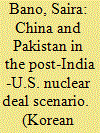

|
|
|
|
|
| Summary/Abstract |
Nuclear relations in South Asia cannot be fully analyzed without taking into account the China factor. After the May 1998 nuclear tests, a substantive amount of strategic literature has been focused on Indian and Pakistani nuclear postures and policies, respectively. However, their integral links with China in transforming South Asia’s nuclear environment remains one critical component that has not
been adequately examined. Multifaceted cooperation, competition and conflict have engulfed this triangle since the India-U.S. nuclear deal. This deal has significantly increased India’s nuclear weapons capability, and hence exacerbated the security dilemma of Pakistan and China, which has important implications for the strategic stability in the region. This paper analyses the strategic implications of this deal for the nuclear triangle and argues that the nuclear triangle will remain complex with inherent risks as well as pose challenges to the region’s strategic stability. China-India-Pakistan nuclear strategies will be determined by the larger triangle of U.S.-China-India relations, which will define the politics of South Asia as well as the larger Asian landscape.
|
|
|
|
|
|
|
|
|
|
|
|
|
|
|
|
| 6 |
ID:
137798
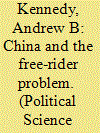

|
|
|
|
|
| Summary/Abstract |
IS CHINA PULLING ITS WEIGHT IN THE INTERNATIONAL SYSTEM? In recent years, China has increased its contribution to United Nations peacekeeping, raised its foreign aid to impoverished countries, and made significant commitments to global arms control initiatives.1 Even so, a rising chorus of voices has charged that China is “free riding” on cooperation undertaken by the United States and other countries that provides benefits to the wider international community. Calling China a free rider is nothing new; scholars described China as free riding on nuclear arms control agreements and international environmental cooperation as early as the 1990s.2 Yet with the United States beset by financial and economic woes in recent years, allegations that Beijing free rides on the United States and other countries have grown more frequent and more impatient. Whether the issue is fighting terrorism or preventing nuclear proliferation, it has become routine—particularly in the United States—to complain that China is not doing enough to support international cooperation.3 The number of articles containing both of the terms “China” and “free rider” in the Factiva database, for example, increased from an average of 39 per year from 2005 to 2009 to 75 per year from 2010 to 2013. Chinese observers, meanwhile, argue among themselves whether China free rides (da bian che) on the collective action of other states.4 Some agree that China should be seen as a free rider, at least in some areas.5 Other Chinese writers disagree and reject the notion that China should take on “even more responsibility” for global governance.
|
|
|
|
|
|
|
|
|
|
|
|
|
|
|
|
| 7 |
ID:
139206
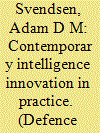

|
|
|
|
|
| Summary/Abstract |
Currently, “macro” systems thinking is arguably most evident in intelligence studies. Appearing especially apparent are characterisations of different intelligence architectures, strongly associated with grander-ranging national or central intelligence systems and their associated machinery, even being bounded as intelligence communities. Following on from noteworthy US defence sector developments, which have demonstrable relevance both to and for closely overlapping contemporary intelligence work, more “micro” systems thinking – namely involving intelligence-related “System of Systems” (“SoS”) concepts – is increasingly emergent. For helping to facilitate and better understand contemporary intelligence innovation, SoS constructs and their dynamics are now deserving of being further examined and refined. This includes as they pertain to the conduct of several multifunctional and special operations occurring across the world during an overall era of globalised strategic risk, and as the study and practice of intelligence aims towards further extension and adaptive transformation.
|
|
|
|
|
|
|
|
|
|
|
|
|
|
|
|
| 8 |
ID:
139190


|
|
|
|
|
| Summary/Abstract |
Though declared as the global common by the world, it is an undeniable fact that internet technology was conceived, developed, and nurtured in the US during the second half of the 20th century. In other words, the US was the cradle for cyber technology, especially the internet, which is currently the backbone of the global communication network. In fact that, the internet is still indirectly governed by US laws which are secretly amended at times to be in tune with its national interest.
|
|
|
|
|
|
|
|
|
|
|
|
|
|
|
|
| 9 |
ID:
137719


|
|
|
|
|
| Summary/Abstract |
We do not yet have strong evidence that the rally effect motivates domestically vulnerable leaders to become engaged in international conflict. We draw upon mechanism design to argue that, if anything, diversionary incentives should be associated with a greater likelihood of being the target of disputes, though the conditions under which the result obtains are restrictive. Our analysis of all dyad-months involving the United States and its rivals for the period from 1956–1996 yields suggestive evidence of the unconventional behavior anticipated by our model, while failing to find evidence of patterns anticipated by either traditional diversionary accounts or strategic conflict avoidance. These results suggest that if we are to better understand international conflict by focusing on diversionary incentives, which may not be very useful, we should focus on the behavior described by our formal model rather than that anticipated by either traditional diversionary accounts or strategic conflict avoidance.
|
|
|
|
|
|
|
|
|
|
|
|
|
|
|
|
| 10 |
ID:
139196
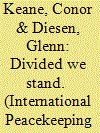

|
|
|
|
|
| Summary/Abstract |
Afghanistan was the first major test for US nation-building efforts in the twenty-first century. Previous analyses have identified many of the barriers that prevented the USA from engaging in effective infrastructure development, governance, security, counter-insurgency and counter-narcotics. Drawing upon interviews with senior US officials, this article offers an alternative account of the nation-building experience that highlights problems within the US government. Building on the assertions of Graham Allison, it focuses on the behaviour of the agencies and individuals within the US bureaucracy. It is argued that a lack of effective leadership permitted bureaucratic disorder between and within the military establishment, the State Department and the United States Agency for International Development (USAID). The conflict that was precipitated by this dissonance prevented the emergence of a cohesive nation-building strategy.
|
|
|
|
|
|
|
|
|
|
|
|
|
|
|
|
| 11 |
ID:
139195
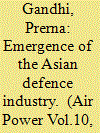

|
|
|
|
|
| Summary/Abstract |
East Asia is a region of contradictions. While it contributes an equal share to world Gross Domestic Product (GDP) as North America, it is also home to four flashpoints: the Taiwan Straits, Korean Peninsula, East China Sea and South China Sea. Countries in the region are bound to each other by economic linkages through trade and production networks, which have led the region to have a joint stake in its shared prosperity. However, increasing economic interdependence, while being a deterrent for conflict, falls short of becoming a cause for peace. Inability to resolve the historical legacies and boundary disputes, the competition for resources, the rise of China, the US pivot to Asia, the unstable regime of North Korea and the changing Japanese security identity are some of the multifarious security problems for the region. This constant clash of strategic aspirations to dominate the region ensures that military instruments will play a critical role in Asia.
|
|
|
|
|
|
|
|
|
|
|
|
|
|
|
|
| 12 |
ID:
137212
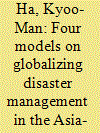

|
|
|
|
|
| Summary/Abstract |
This study contributes to disaster management in the Asia-Pacific region by examining four models: the United Nations/International Strategy for Disaster Reduction (UN/ISDR) professional coordination, US surveillance-oriented management, Korean copy-oriented efforts, and Indonesian homogenization-based action. Based on the comparative perspective, as well as basic concepts on global disaster management, the study cross-checks two features of global disaster management, namely, political interests and dynamic culture, and three comparative variables, namely, stakeholders, resources, and strategies, in each model. The biggest contribution of the study is that it more rigorously examines the comparative analytical framework of the four models. The key tenet is that the above-mentioned models have to address the continuous study of local culture and the job security of employees (UN/ISDR model), more partnership with private institutions and feasible training (US model), long-term international study and creative strategies (Korean model), and gender-sensitive management and information exchange (Indonesian model), by further utilizing both global education and networks.
|
|
|
|
|
|
|
|
|
|
|
|
|
|
|
|
| 13 |
ID:
137799
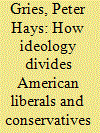

|
|
|
|
|
| Summary/Abstract |
IN A SERIES OF ARTICLES AND A BOOK ON THE ISRAEL LOBBY, realist international relations theorists John Mearsheimer and Stephen Walt argued in 2006–2007 that America's virtually unqualified support for Israel was damaging the U.S. national interest. “Now that the Cold War is over, Israel has become a strategic liability for the United States,” they argue. “Washington's close relationship with Jerusalem makes it harder, not easier, to defeat the terrorists who are now targeting the United States.”1 America's disastrous Middle East policy, they further contend, is best explained by the pernicious influence of the “Israel lobby” in Washington, especially wealthy Jews and the right-wing American Israel Public Affairs Committee (AIPAC).
|
|
|
|
|
|
|
|
|
|
|
|
|
|
|
|
| 14 |
ID:
137593
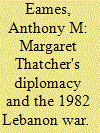

|
|
|
|
|
| Summary/Abstract |
The year 1982 emerged as pivotal in the Atlantic Alliance and the relationship between President Ronald Reagan and Prime Minister Margaret Thatcher. On 6 June 1982, Israeli Defense Forces breached the Lebanese border in a maneuvre to eradicate the Palestinian Liberation Organization. The campaign opened a violent episode in the decades-old Arab-Israeli conflict. Almost immediately the British Foreign and Commonwealth Office recognized the challenge to the international community. The crisis in the Middle East occurred during a period of substantial turnover in the foreign policy communities of both London and Washington. Subsequent improved bilateral relations between the United States and the United Kingdom paved the way for greater cooperation in international diplomacy between respective national executives.
|
|
|
|
|
|
|
|
|
|
|
|
|
|
|
|
| 15 |
ID:
137492


|
|
|
|
|
| Publication |
New Delhi, Manas, 2014.
|
| Description |
543p.Hbk.
|
| Standard Number |
9788170494744
|
|
|
|
|
|
|
|
|
|
|
|
Copies: C:1/I:0,R:0,Q:0
Circulation
| Accession# | Call# | Current Location | Status | Policy | Location |
| 058170 | 327.120954/YAD 058170 | Main | On Shelf | General | |
|
|
|
|
| 16 |
ID:
137554
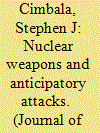

|
|
|
|
|
| Summary/Abstract |
Anticipatory attacks come in two forms. Preemptive attacks are first strikes based on the assumption that the opponent has already set an attack in motion or is about to, and the purpose of the preemption is to mitigate or neutralize the effect of the enemy’s move. Preventive wars, on the other hand, are undertaken to preclude a threatening power from increasing its capabilities relative to ours, assuming that smaller differences in power will lead the challenger to become more risk acceptant. With respect to nuclear weapons, deterrence is intended to preclude both preemptive and preventive attacks, although the former is judged to be more likely than the latter. Leaders authorizing a nuclear preemption would need to have high confidence about the intentions as well as the capabilities of the other state, and the requirements for fine-grained intelligence would be considerable, prior to any actual launch of delivery systems. Seeing into the other side’s world view, regardless of its apparent rationality or lack thereof, would also be prudent before undertaking a decision of such magnitude.
|
|
|
|
|
|
|
|
|
|
|
|
|
|
|
|
| 17 |
ID:
137797
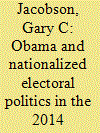

|
|
|
|
|
| Summary/Abstract |
Analyzes the 2014 midterm congressional elections. He finds that, in aggregate, the electorate treated the midterm as a referendum on the economy and particularly Barack Obama’s presidency, producing the most partisan, nationalized, and president-centered midterm election in at least 60 years.
|
|
|
|
|
|
|
|
|
|
|
|
|
|
|
|
| 18 |
ID:
137558


|
|
|
|
|
| Summary/Abstract |
The T-34 was the most mass-produced tank of WWII. No wonder that it has become one of the most famous and well-known tanks of that period. Numerous authors have repeatedly described it as the finest combat vehicle of its time. But, as is usually the case, this tank had both values and weaknesses. Many of them were revealed in 1942–1943 when one of the T-34s was comprehensively tested by American military experts on Aberdeen Proving Ground in Aberdeen, MD. Some Soviet officers were present there as well. They collected and recorded the Americans’ statements and conclusions about the tank. In August 1943 an official report summarizing the Americans’ evaluation was sent to Moscow. Its contents startlingly differ from the common opinion about the T-34 and can surprise many readers. This article analyzes that report in detail, item by item, and explains the reasoning behind each. It also briefly outlines the history of T-34’s engineering and production and the roles of the people involved. As a result it makes it perfectly clear why this tank was the way it was, what were its real values and weaknesses, and why it had become so important for the Red Army during its struggle with the Wehrmacht in 1941–1945.
|
|
|
|
|
|
|
|
|
|
|
|
|
|
|
|
| 19 |
ID:
137213
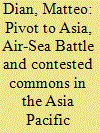

|
|
|
|
|
| Summary/Abstract |
The Pivot towards the Asia Pacific has been a key component of the grand strategy of the Obama administration. Militarily, the main challenge is represented by the Chinese capacity to erode the American ‘command of the commons’.
The United States have been developing a new operational concept, labelled ‘Air-Sea Battle’ (ASB) aimed at maintaining the capacity to project military power even if adversaries are able to deploy a sophisticated anti-access area denial strategy.
The implementation of ASB is likely induce Beijing to respond with a further acceleration of the process ofmodernisation of its armed forces.
|
|
|
|
|
|
|
|
|
|
|
|
|
|
|
|
| 20 |
ID:
137443


|
|
|
|
|
| Summary/Abstract |
The USS Enterprise naval task group entry into the Indian Ocean during the closing stages of 1971 Indo-Pak Conflict led to further deterioration in the relations between India and the United States (US), and this estrangement lasted until the end of the Cold War. The US couched this show of force under the rubric of ensuring safety of American personnel caught up in a war zone. In India, however, this was seen as a coercive attempt to prop up a genocidal military regime. Using recently declassified official records from both sides, additional scholarly works on the 1971 conflict, and in light of the rapprochement in Indo-US relations, the article attempts to deconstruct the rhetoric and reality of this incident. It examines the prevailing politico-strategic environment, roles of diplomatic-military apparatus of major players, the mechanics of the naval deployment, and provides lessons for historical re-interpretation and the utility of seapower in the contemporary context.
|
|
|
|
|
|
|
|
|
|
|
|
|
|
|
|
|
|
|
|
|